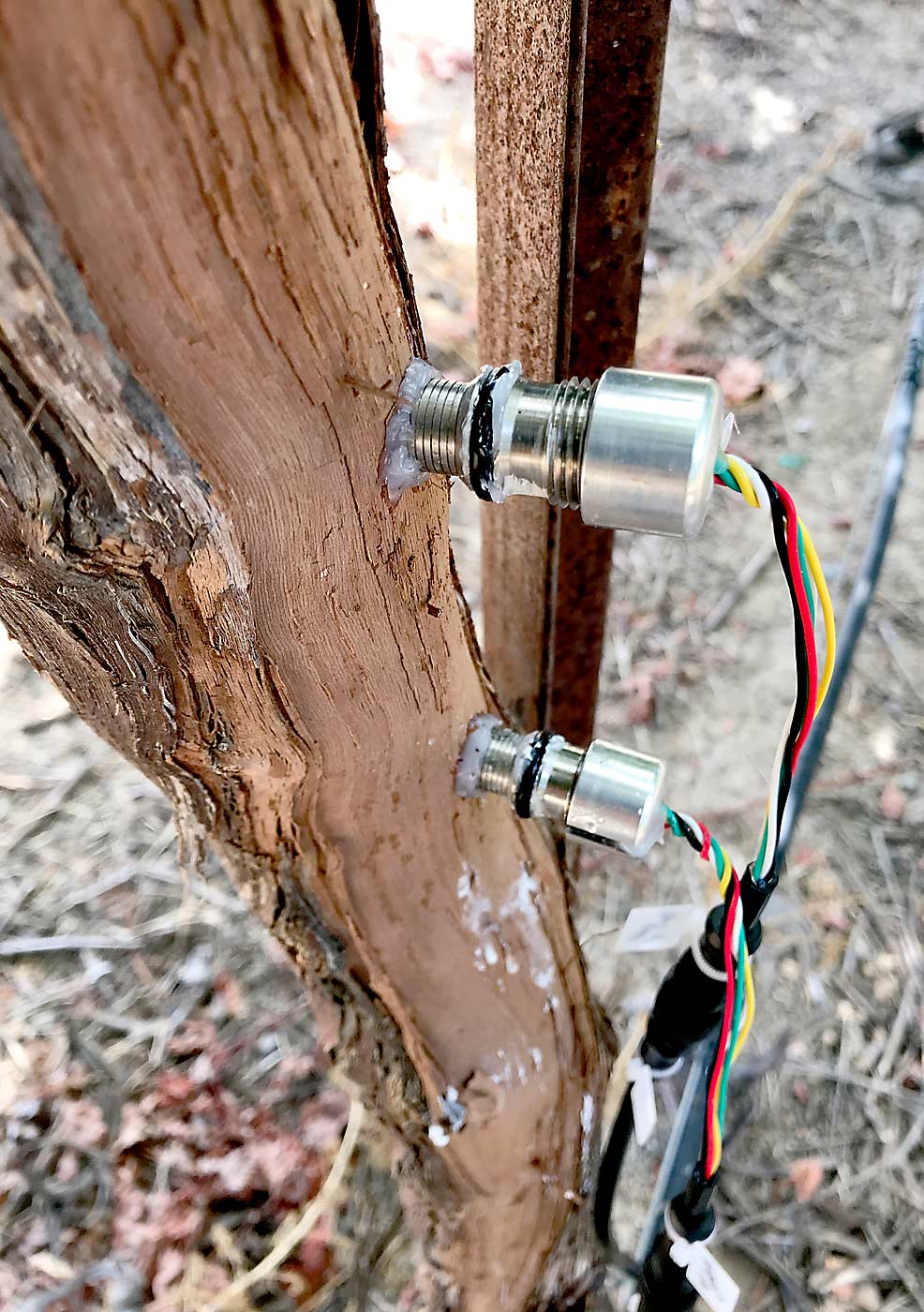
Imagine the perfect irrigation sensor.
University of California, Davis professor and irrigation expert Ken Shackel knows what it should measure.
“If I irrigate more, will I get more profit? Or less profit? Everything else is incidental to what you are trying to accomplish,” Shackel said in a talk at the Washington Winegrowers Association’s annual meeting in March. “But we don’t have a sensor that measures that economic effect.”

Until then, new gizmos and apps continue to roll out every year, each taking a slightly different approach to tell you how thirsty your vines are. They promise to help growers save water, improve fruit quality and someday provide a tool to show regulators that growers are irrigating as sustainably as possible.
“It’s a different mindset for irrigation scheduling,” Shackel said. “You ask the plant, ‘How do you feel?’ and then you adjust your schedule to make the plant feel what you want it to feel.”
There’s no perfect sensor yet, but tech-curious growers have plenty to consider. Before deciding what technology to try, ask yourself what you want it to tell you. Some approaches primarily tell you when to irrigate, while others tell you how much.
When?
To ask the plant directly how thirsty it feels, Shackel said, growers and researchers rely on pressure chamber measurements of stem or leaf water potential. That measures how hard the plant has to work to pull water from the soil.
But it’s far from automated; someone has to haul it to the field once a week to record data.
“It’s like trying to play the stock market when you can only get data when you close on Friday,” said longtime Cornell University physiologist Alan Lakso, who spent years working on a sensor that could be embedded in a vine or tree to measure the stem water potential in real time.
Now retired, Lakso, Cornell engineer Abe Stroock and his former graduate student, Michael Santiago, have since formed a company, FloraPulse, to commercialize the microtensiometer they designed. They sold it to a limited number of customers this year, CEO Santiago said, with full service for $1,500 per installation per year. So far, wine grape, almond and stone fruit growers in California have expressed interest, but the technology is not yet commercially available in Washington.
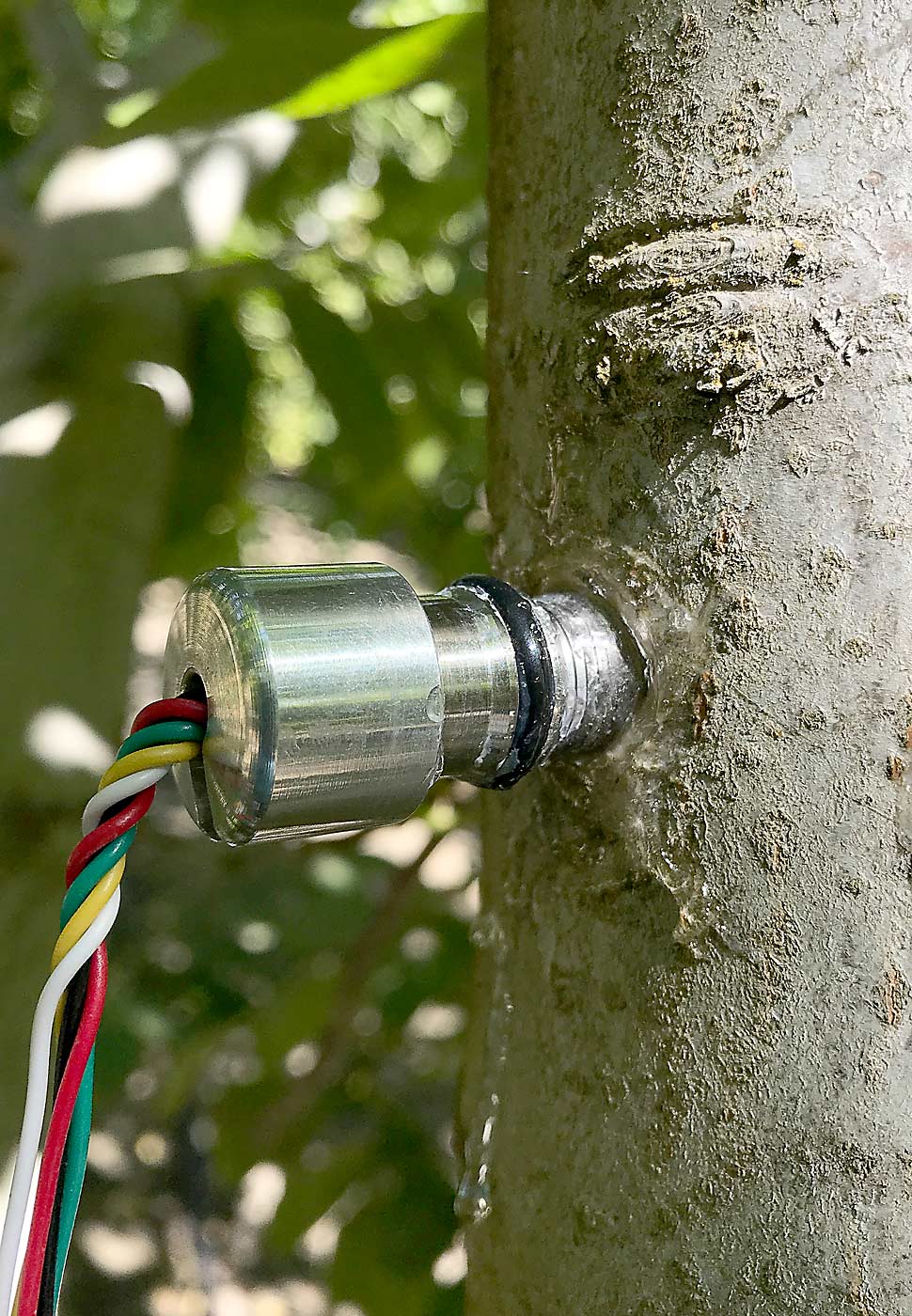
The data comes in the form of an app that plots daily stem water potential against thresholds based either on recommendations from UC Davis for almonds or prunes or by working with wine grape growers to set their own, Santiago said.
“We believe automated irrigation is coming and we’re going to be a part of that,” he said. “Growers could save a lot of water, and what we’re doing really fits in well with the way water management is going, at least in California.”
Taking measurements directly inside the vine has pros and cons. On the plus side, direct measurements eliminate the need to account for any other correlated factors, Lakso said. The challenge lies in keeping an electronic sensor reliable in a wet environment, inside a trunk that’s swelling and shrinking in response to temperature and photosynthesis.
The sensors themselves perform very reliably, but the installations can fail if the plant responds by gumming up around the wound, as some stone fruit does, he said. To account for that, FloraPulse currently installs two sensors in the same vine, so that if there is a failure, it’s easy to catch, Santiago said.
Sap flow sensors — a plant water stress technology that’s been commercially available for about a decade — aim to provide similar information but have the opposite pros and cons.
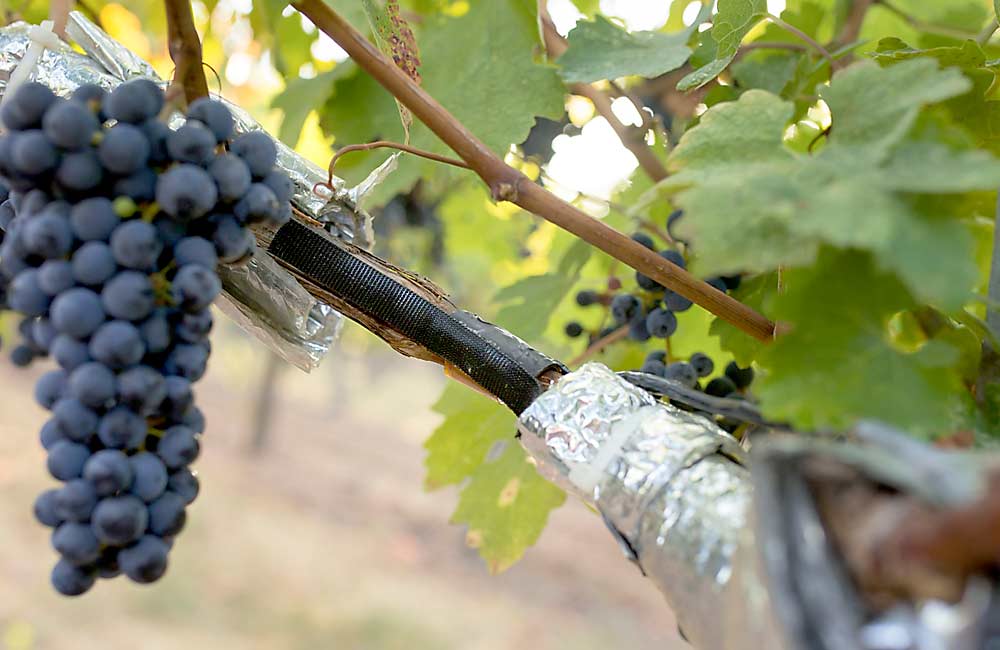
This flow meter-like technology uses a heating sleeve and a pair of temperature sensors to measure how the heat changes from point A to point B, and therefore how much water is flowing through the vines carrying that heat, according to Sebastien Payen, co-founder of Fruition Sciences, a French company that uses sap flow sensors as the basis of its water stress app for growers. It helps growers to save water and improve fruit quality, he said.
Shackel calls this type of measurement an indirect measurement of water stress, because other factors that are tangled up in how the plant responds to water stress can influence what the sap flow sensors measure as well. Ideally, the measurement should be compared to well-watered vines in the same block.
Payen said Fruition Sciences’ technology does not need calibration beyond what the app provides: a reference evapotranspiration coefficient that represents the maximum transpiration possible during those weather conditions if the vine had no water deficit. Evapotranspiration (ET) is the amount of water the plant loses through respiration and soil evaporation.
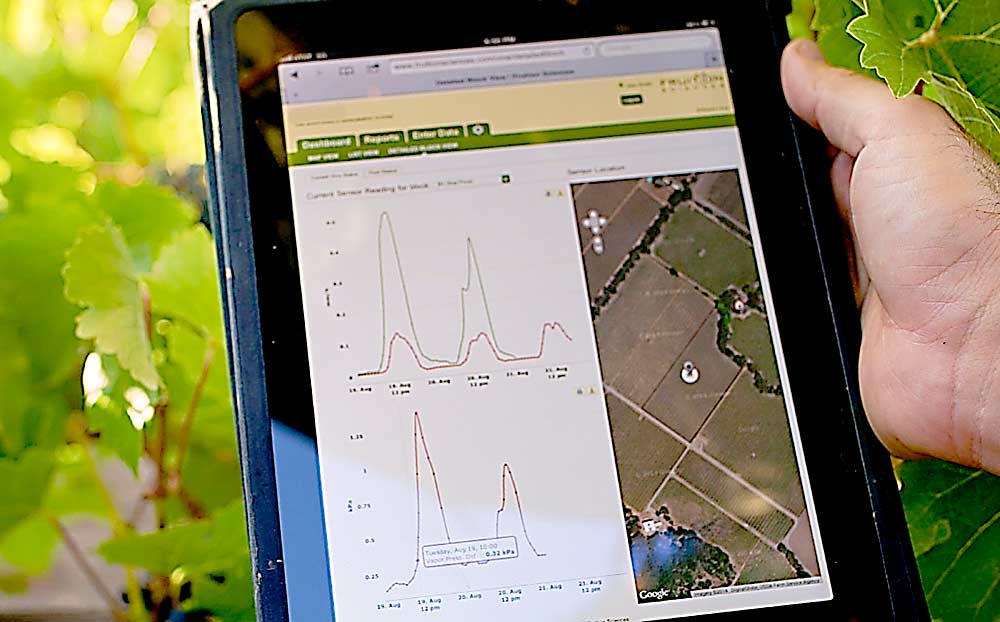
“It’s a tool for the winemaker to really understand what the vines are feeling,” Payen said. His customers in California cut their water use in half, on average. “It’s a way to push your vineyards to adapt to drought and it gets better as time goes by,” he said.
Do growers need these real-time estimates of what’s going on in the vine?
“You might ask me, ‘Is it worth it?’ My answer is, ‘If you think so,’” Shackel said. “I suspect it will.”
Researchers think it’s worth it. Washington State University scientists in Prosser and Wenatchee plan to run wine grape and tree fruit trials with the FloraPulse sensors this year. As a research tool, Lakso said, the technology will provide deeper insight into how best to irrigate a variety of crops.
“Now people will have the opportunity to really dial in and answer questions we hadn’t been able to ask previously,” he said. “It opens the door to a lot of new thinking and testing and learning about how to save water and to use it in the most efficient way to get the important quality or yield or fruit size.”
How much?
Data from weather stations have long provided farmers ET estimates to help determine how much to irrigate, but reference ET provided by regional weather stations isn’t vineyard block-specific.
That’s where California-based Tule Technologies comes in. Founder Tom Shapland developed the technology the company commercialized, as a graduate student at UC Davis.
A tower installed over a vineyard measures the actual ET from a local area, about 1 to 5 acres, Shapland said. “Our customers input water stress targets and we tell them how much to irrigate to stay within their targets.”
In practice, growers put the tower in a representative area for an entire irrigation block. Each installation costs $1,500 annually, including all servicing, but it’s not yet available in the Pacific Northwest.
“I try to put a Tule tower in a location where it’s going to inform as many blocks as possible,” said Chris Storm, viticulturist for the 15,000-acre Vino Farms in Lodi, California. “It’s hard science that I am using to cost-engineer the rest of my farming, my irrigation recommendations.”
He uses the towers to measure actual ET for a block and aerial imagery every two weeks to examine stress levels in other areas of the ranch, so he can infer where the ET likely applies, he said. “Then I say, ‘This block’s going to need 16 hours this week and I’m going to need to reapply in 10 days,’” Storm said.
The underlying technology involves the physics of airflow and heat transfer, called surface renewal. It’s not a new idea, but Shapland figured out the physics of the process to allow the key measurements to be taken with more affordable sensors, so the idea moved from research tool to commercial product.
“We look at how the wind is carrying the water vapor away from the field,” he explained.
Then, his models use that measurement of water use and compare that to potential use in terms of weather and canopy size, to provide growers plant stress assessments to help them decide when and how much to irrigate to stay in their target range.
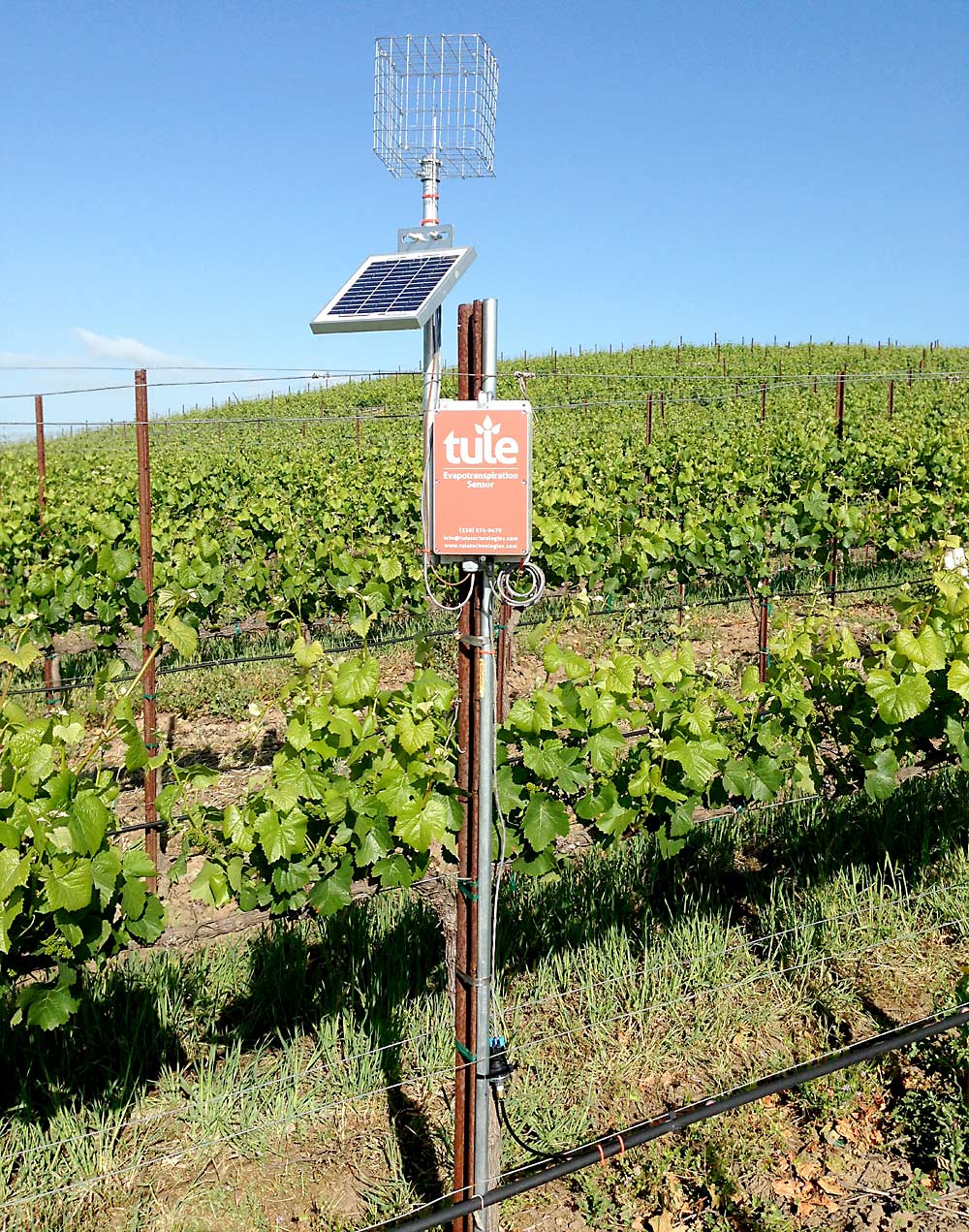
Where?
The limitation with any expensive new sensor is deciding where to put it, and growers can’t afford to put them everywhere.
To better assess variability, Tule launched a new product called Tule Vision. It uses smartphone photos of vines to make water stress readings. The readings are based on a computer model that’s learned to see stress signals in thousands of vine pictures paired with pressure bomb readings, Shapland said.
“We want to replace the pressure chamber with this product,” Shapland said, using it to provide the plant stress indicator for when to irrigate, complementing the actual ET for how much. Or, some growers may want to use it as a stand-alone.
Storm, in Lodi, beta-tested this system last season and he’s very excited about the potential.
“It’s going to replace aerial imagery,” he said, envisioning Tule’s app running on a camera mounted to a tractor or quad, collecting water stress readings along each row. “It’s more real-time, you can get it the day you want it.”
Several other companies are working on vision-based water stress sensing as well, but the technology isn’t yet proven, Shackel said.
For now, each technology acts as one piece of a decision tree, rather than a stand-alone solution, Storm said. Many other growers agree, combining plant stress sensors with aerial imagery, soil probes and boots on the ground in their vineyards.
“We can’t just rely on one technology,” said Sadie Drury of North Slope Management in Walla Walla, Washington. She uses the Fruition Sciences sap flow sensor in combination with the spatial data from weekly drone flights. “But I don’t look at my soil probes much anymore.” •
—by Kate Prengaman






Leave A Comment